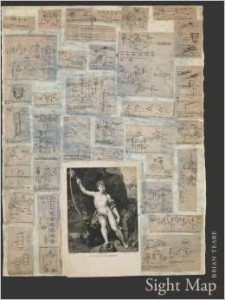
Sight Map
by Brian Teare
University of California Press
Reviewed by Jeremy Reed
Sometimes, collections of poetry have a central theme, concern, or conceit. Other times, poetry’s speakers don’t employ such a singular perspective but, rather, walk forward into the world exposed, vulnerable, and open to influence, encountering whatever also encounters them. I see Brian Teare’s recent poetry as more present in this second route, intentionally leaving itself and its readers importantly at risk, open to involvement in a larger, multivalent world.
Teare’s poetic voice is what many poets attempt but not all achieve: singular while attentive to its poetic origins, innovative while influenced, experimental while tied to specific traditions. These connections with other poets and thinkers are wide-ranging and evocative, encompassing writers as diverse as Hopkins, Emerson, and the Black Mountain poets (especially Robert Duncan), but it is perhaps in his second book, Sight Map, that the scope of Teare’s poetic vision first gives his readership a glimpse into the power of his poetic abilities and the scope of his reach.
Throughout Sight Map, the tensions between faith or belief, the body, disease, and desire pull with them and are pulled by plant life, animals, and landscape. As Teare writes in the poem “Lent Prayer,” “As prayer is / route to precarious, the river trembles on its treadle.” This precariousness, perhaps reminiscent of Judith Butler’s recent work on ethics, inhabits Teare’s poems, keeping our attention clear and focused, while allowing language the space to reach toward loose resonance and sometimes dissonance with other’s ideas. Teare approaches the concept of embodiment repeatedly, connecting poetry to a language of prayer. For him, that language is constituted of questions left unanswered, leaving his speakers and readers to continue asking “how a birch shirks its skins” when neither the birch nor any of us asked to be embodied to begin with. He returns to such ideas often, never with a totalizing answer and always leaving open a space for response. As he does in the poem “Theory of Trees (White Birch)”, Teare juxtaposes the multiple aspects of each of his themes, describing embodiment as “awful / beautiful : never- / lasting” – all at once.
Central to this concern of embodiment is one of Teare’s many through-lines: a narrative of a partner’s death that leads to a questioning of the body, its beauty and its reliability. This embodied openness to instability and risk exists in his poems as tied to language, specifically language’s quality of being always only a scaffold for the meaning it never quite fully reaches while simultaneously maintaining an “impossibility of emptiness.” Teare writes in one of the prose poems in the “Pilgrim” section of the text, “As being is to begin.” Being and beginning and their overlap are central to the question of language and the body in Sight Map. These poems remind us through their example that while emptiness is impossible in the scaffold of language, we never cease searching for more good questions to ask in continuously different ways. We are always seeking a better language through these questions, an asking central to our being, our beginning to live.
But what makes a good question to ask? Near the end of his book, Teare critiques the difficulty we often have in seeking these open-ended questions that allow vulnerability, but in doing so he turns our attentions toward possibilities of how to live, how to ask in an embodied, precarious world:
& it isn’t ever,
is it, the how
to live it
so it doesn’t
kill you,
the where
to touch it,
the when
will genius
sing your name
so it sounds
like a place
you can live?
You can hear Sight Map’s particular gift here: creating maps built on sight ever-changing, never ceasing to saunter through whatever the landscape may be: grief, beauty, language, poetry, belief. Teare’s speakers are there, always moving, repeating, re-approaching – reminding us we have the language to remain importantly vulnerable to ourselves and each other, too.
_____________________________
Jeremy Reed lives in Missoula, Montana. He holds an MA in Literature from the University of Montana and has published creative work in The Cresset and Camas: The Nature of the West.
A former Stegner Fellow at Stanford University, Brian Teare is the recipient of poetry fellowships from the National Endowment for the Arts, the MacDowell Colony, the Marin Headlands Center for the Arts and the American Antiquarian Society. He’s the author of four full-length books, The Room Where I Was Born, Sight Map, the Lambda-Award-winning Pleasure, and Companion Grasses, one of Slate’s best poetry books of 2013 and a finalist for the Kingsley Tufts Poetry Award. He’s also published seven chapbooks: Pilgrim, Transcendental Grammar Crown, ↑, Paradise Was Typeset, Helplessness, [ black sun crown ], and SORE EROS. After over a decade of teaching and writing in the San Francisco Bay Area, he’s now an Assistant Professor at Temple University in Philadelphia, where he makes books by hand for his micropress, Albion Books.
